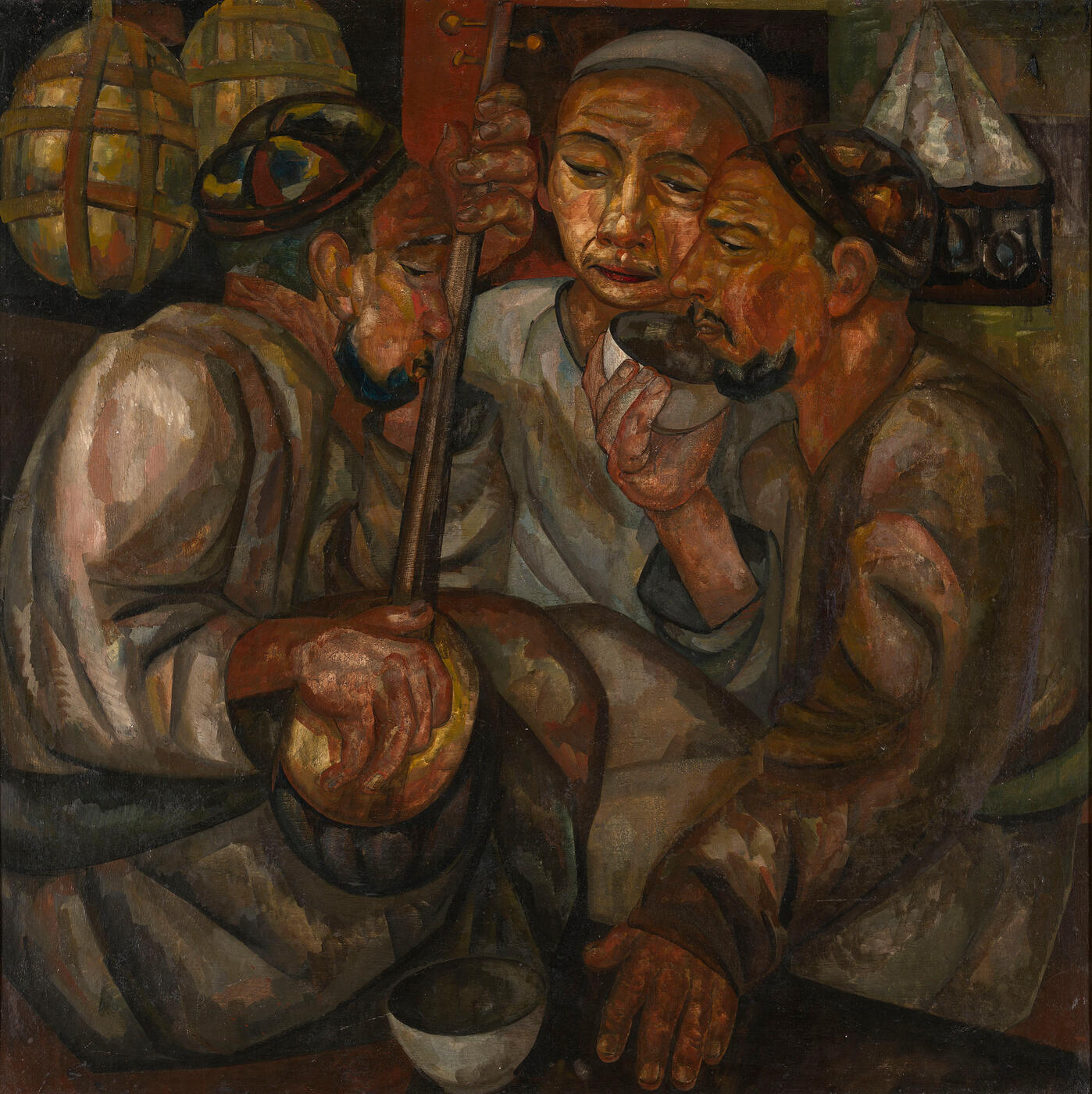MacDougall's Russian Art Auctions 1 December 2011
1 December 2011

* 12. VOLKOV, ALEKSANDR (1886-1957)
Listening to the Bedana, signed.
Oil on canvas, laid on board, 97.5 by 97.5 cm.
300,000-500,000 GBP
Executed in the 1920s.
Provenance: Acquired directly from the artist’s family by the Ministry of Culture of the USSR, probably in the 1960s.
Acquired from the above by an American dealer.
Private collection, USA.
Authenticity of the work has been confirmed by the artist’s family.
Exhibited: Russian Exhibition. Contemporary Paintings, Drawings and Sculptures Directly from the U.S.S.R., Saks Galleries, Colorado, November 1975.
Literature: Exhibition catalogue, Russian Exhibition. Contemporary Paintings, Drawings and Sculptures Directly from the U.S.S.R., Saks Galleries, Colorado, November 1975, illustrated.
Aleksandr Volkov was one of the most brilliant representatives of the “Eastern avant-garde”. His Uzbek imagery entered art history for the bold addition it made to traditional Orientalism, approached with the geometrisation and division of space found in Cubism, Futurism and Suprematism.
Listening to the Bedana, painted in the 1920s, belongs to a new stage in this artist’s career in which he experimented with figurative representation. Volkov summed up this period of his life in his diary: “The road to Realism. Themes of mountain villages. Fergana. Chaikhanas”. The complexity of these experiments, which soon led him away from the mainstream of Soviet art, resulted in the artist being accused of wandering the “labyrinth of formalism”, which had already been noted in his cycle of “musical” compositions of the 1920s.
In terms of subject-matter Listening to the Bedana is a direct continuation of the artist’s celebrated masterpiece Listening to Music, but at the same time there is much in it that relates to the composition of his equally well-known Chaikhana paintings. Here the artist again tackles his two favourite motifs in the same picture, those of oriental tea-drinking and music-making. By portraying them in close-up, Volkov demonstrates his characters’ detachment from everyday life and their concentration on enjoying the music. Despite the simplicity and prosaic nature of the subject matter, this is not a genre scene set in a chaikhana but rather an epic work. We are witnessing not simply tea-drinking, but a silent, meaningful conversation between three worldly men: this work, which is extraordinary for its emotional expressiveness, is thereby raised to the level of a metaphorical depiction of the theme of music awakening the human soul. In the 1920s the artist was seized by an interest in folk culture and a sense of affinity with his national heritage. He was captivated by the sounds of the bazaars and provincial streets and it is thus music that is the quintessence of his best works of that period.
In this scene Volkov is consciously avoiding the plethora of oriental sounds and colours which characterise his more primitivist version of Listening to the Bedana, Singers-Uzbeks and Chaikhana. Listening to a Song. The protagonists’ robes and skull-caps, imbued with shadows and coloured highlights, are austere and without a great deal of colour. The conceptual and colour focuses are provided by the bedana in its white cage hanging against the background wall in the upper right; the shining face of the central figure, lost in the song of the quail and the sound of the dutar; and the dutar itself, its pearshaped, mulberry-wood body transformed into an immaterial conglomeration of luminous colour.
One role of the chaikhana is to bring peace, to offer rest and the time for reflection. For this reason everything in this picture remains faithful to everyday life and is accurate in terms of volume, space and what is depicted. A sense of music is conveyed with extraordinary precision by the simplest, most economical of means. We have the impression that Volkov’s work is pictorially reproducing the accidental musical ensemble created by the singing bird and the dutar accompanying him, the rhythm of which is based on monody and monophony and has the same hypnotic effect as the song of the quail which is valued in Central Asia for its loud, monotonous, continuous cry. There are no details, no decorations. The only three people in the world have been united by the music. One is playing the dutar, another raises a tea-bowl to his mouth and the third, clothed all in white, is sunk in the contemplative meditation of Sufism. The dark background of a wall, from which melons stand proud against the background with the bedana (the same word in Uzbek signifies both the quail and the cage which holds him), emphasises the precision of the men’s silhouettes and the extreme dynamism of the vibrant colours used for their faces.
The artist concentrates all his attention on the economically rendered, powerful masses of the human figures. These are human monoliths. The forms of their bodies are simply-rendered and sculptural, “fluid” and yet full of energy, like a coiled spring. At the same time all the protagonists have some kind of superior strength, especially evident in the treatment of the hands, reminding us of the forms of Picasso’s Neo-Classical period. It is no coincidence that the art historian Aleksei Sidorov noted as early as the 1920s that “in many of Volkov’s pieces there is more of Paris than of Tashkent, more of Matisse and Picasso than of the oriental rug”.
Fusing together the local colour of his native Uzbekistan with experiments in the new figurativeness art that was prevalent in the second half of the 1920s, Volkov proved to be in tune with the international hunger for this new objectivity, endowing Listening to the Bedana with a supra-national significance.
Notes on symbols:
* Indicates 5% Import Duty Charge applies.
Ω Indicates 20% Import Duty Charge applies.
§ Indicates Artist's Resale Right applies.
† Indicates Standard VAT scheme applies, and the rate of 20% VAT will be charged on both hammer price and premium.